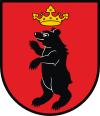Łuków
| Łuków | ||
|---|---|---|

Railroad station in Łuków
|
||
|
||
| Coordinates: 51°55′38″N 22°23′00″E / 51.92722°N 22.38333°ECoordinates: 51°55′38″N 22°23′00″E / 51.92722°N 22.38333°E | ||
| Country |
|
|
| Voivodeship | Lublin | |
| County | Łuków County | |
| Gmina | Łuków (urban gmina) | |
| Government | ||
| • Mayor | Dariusz Szustek | |
| Area | ||
| • Total | 35.75 km2 (13.80 sq mi) | |
| Population (2006) | ||
| • Total | 30,564 | |
| • Density | 850/km2 (2,200/sq mi) | |
| Time zone | CET (UTC+1) | |
| • Summer (DST) | CEST (UTC+1) | |
| Postal code | 21-400 | |
| Car plates | LLU | |
| Website | www |
|
Łuków [ˈwukuf] is a city in eastern Poland with 30,727 inhabitants (as of January 1, 2005). Since 1999, it has been situated in the Lublin Voivodeship, previously it had belonged to the Siedlce Voivodeship (between 1975–1998). It is the capital of Łuków County.
The town has an area of 35.75 km2, of which forests make up 13%. Łuków is located on the Southern Krzna river, at approximately 160 meters above sea level. The name of the town first appeared in documents in 1233 (Castelani nostri de Lucow). Łuków comes from Old Slavic word łuk, which means "a place located in a wetland". For 500 years Łuków, together with neighboring towns Siedlce and Radzyń Podlaski, was part of Lesser Poland, and was located in the extreme northeastern corner of the province. After Partitions of Poland (late 18th century), it belonged to Russian-controlled Congress Poland. Some time in the 19th century, it became associated with another historical region of Poland, Podlasie.
Łuków was established as a grod, around the year 1233. It guarded eastern border of the Sandomierz Land, against warring tribes from the East including the Yotvingians and the Lithuanians. In the first half of the 13th century, Łuków was the seat of Lesser Poland's castellany, positioned in a strategic corner of the province. After prince of Kraków and Sandomierz Bolesław V the Chaste brought here the Knights Templar (1250–1257), a Roman Catholic Diocese of Łuków was established here. It existed for a very short time (1254–1257), and was closed after protests of the Teutonic Knights. In the late Middle Ages Łuków was frequently invaded and destroyed by the Old Prussians, Yotvingians, Lithuanians and Tatars. The city life improved only after 1385 (see Union of Krewo), when Poland and Lithuania became allies. In 1403 Łuków was officially granted a charter, codifying its legal status. The town originally belonged to the Sandomierz Voivodeship, but in 1474, it became part of the Lublin Voivodeship (1474–1795).
...
Wikipedia


